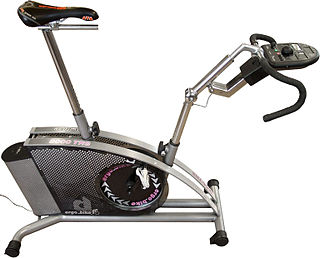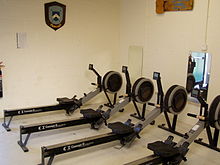
An indoor rower, or rowing machine, is a machine used to simulate the action of watercraft rowing for the purpose of exercise or training for rowing. Modern indoor rowers are often known as ergometers because they measure work performed by the rower. Indoor rowing has become established as a sport, drawing a competitive environment from around the world. The term "indoor rower" also refers to a participant in this sport.

Rowing, often called crew in the United States, is the sport of racing boats using oars. It differs from paddling sports in that rowing oars are attached to the boat using rowlocks, while paddles are not connected to the boat. Rowing is divided into two disciplines: sculling and sweep rowing. In sculling, each rower holds two oars, one in each hand, while in sweep rowing each rower holds one oar with both hands. There are several boat classes in which athletes may compete, ranging from single sculls, occupied by one person, to shells with eight rowers and a coxswain, called eights. There are a wide variety of course types and formats of racing, but most elite and championship level racing is conducted on calm water courses 2 kilometres (1.2 mi) long with several lanes marked using buoys.

A stationary bicycle is a device used as exercise equipment for indoor cycling. It includes a saddle, pedals, and some form of handlebars arranged as on a (stationary) bicycle.

The Rowperfect is an indoor rowing machine, designed in 1987 and patented in 1988, by Casper (Cas) Rekers. It is designed to accurately simulate the feeling of rowing on the water. Both the flywheel and the seat are free to move on a slide — this is different from the majority of rowing machines, where the flywheel is fixed and only the seat moves. Its mass and movement are balanced and engineered to enable rowing technique to be learned and refined. This is called a "floating head" rowing simulator: the fixed flywheel type is called a "fixed head" ergometer.
Richard Alan Dreissigacker is a former American Olympic rower and a founder of Concept2, a manufacturer of rowing equipment. While studying engineering at Brown University he took up rowing and went on to represent the United States at the 1972 Summer Olympics.

Rowing is the act of propelling a human-powered watercraft using the sweeping motions of oars to displace water and generate reactional propulsion. Rowing is functionally similar to paddling, but rowing requires oars to be mechanically attached to the boat, and the rower drives the oar like a lever, exerting force in the same direction as the boat's travel; while paddles are completely hand-held and have no attachment to the boat, and are driven like a cantilever, exerting force opposite to the intended direction of the boat.
In competitive rowing, the following specialized terms are important in the corresponding aspects of the sport:

In rowing, oars are used to propel the boat. Oars differ from paddles in that they use a fixed or sliding fulcrum, an oarlock or rowlock attached to the side of the boat, to transfer power from the handle to the blade, rather than using the athlete's shoulders or hands as the pivot-point as in canoeing and kayaking.
The Marin Rowing Association, located in Greenbrae, California, US is a rowing association and non-profit organization founded in 1968 by Coach R.C. "Bob" Cumming.

The McGill University Rowing Club (MURC) is a rowing club that represents McGill University in Montreal, Quebec, Canada. The club is currently a Level 2 intercollegiate program and thus receives partial funding from the university. As the only Quebec university with a varsity rowing program, the club participates in the Ontario University Athletics (OUA) conference. It is a registered club with Rowing Canada.

Newcastle University Boat Club (NUBC) is the rowing club of Newcastle University, UK. Established in March 1911 as the boat club for Armstrong College, it celebrated its centenary in 2011, when was also appointed High Performance Programme for heavyweight men and women by British Rowing. In the past 20 years current students and alumni won 60 international vests for GB.
Graham Benton is a British indoor rower. He has won the British Rowing Indoor Championships 15 times and the World Indoor Rowing Championships six. While Benton is primarily an indoor rower, he did row on the water, representing England and competing at several Henley Royal Regattas.
ALFA is the biggest indoor rowing competition in the Baltics raced over 1,000 m on Concept2 indoor rowers. The first competition in Estonia on Concept2 rowing ergometers took place at the end of 1993 in the hall of the Lootos sports association. There were 54 participants in the competition, initiated by the Tallinn Rowing Club. In 1995, the second rowing ergometer competition took place in the sports facilities of Flora with the third event occurring at the same venue in 1996.
Elliot Meyer Hovey is an American rower who participated in the 2008 Summer Olympics and 2012 Summer Olympics.

Dave Holby is a British indoor rowing endurance world record holder. On 18 December 2010 he became the first person to row the virtual distance around the earth's equator (40,075 km) on a Concept2 land rowing machine, setting a new Guinness World Record of 934 days. The record appears in the 2013 Guinness Book of World Records. He has raised over £40,000 for a number of charities, chiefly Breakthrough Breast Cancer. In May 2011, he was awarded the Mayor's Medal for his contribution to the borough of Basingstoke and Deane. In November 2012 he became Patron of Support through Sport UK, a national charitable trust that aims to use sport to change people's lives.

Wadham College Boat Club (WCBC) is the rowing club of Wadham College, Oxford, in Oxford, United Kingdom. The club's members are students and staff from Wadham College and Harris Manchester College. Founded circa. 1837, Wadham has had success both within Oxford and externally in regattas such as Henley Royal Regatta.

Samuel Loch is an Australian former representative rower. A dual Olympian and two time bronze medal winner at World Championships, he has set and holds world records in indoor rowing with times set on the Concept 2 rowing machine.

Cantabrigian Rowing Club, known as Cantabs, is a 'town' rowing and sculling club in Cambridge, UK.
Aliaksandr Kazubouski is a Belarusian rower. He competed at the 2008 Summer Olympics and the 2012 Summer Olympics. Won the world title in 2012 World Rowing Championships in Plodviv, Bulgaria. Won the European Title in 2010 European Rowing Championships in Montemor-o-Velho, Portugal. In 2011 Kazubouski, as part of the team Dynamo Brest, competed in the Stewards' Challenge Cup at Henley Royal Regatta.
















